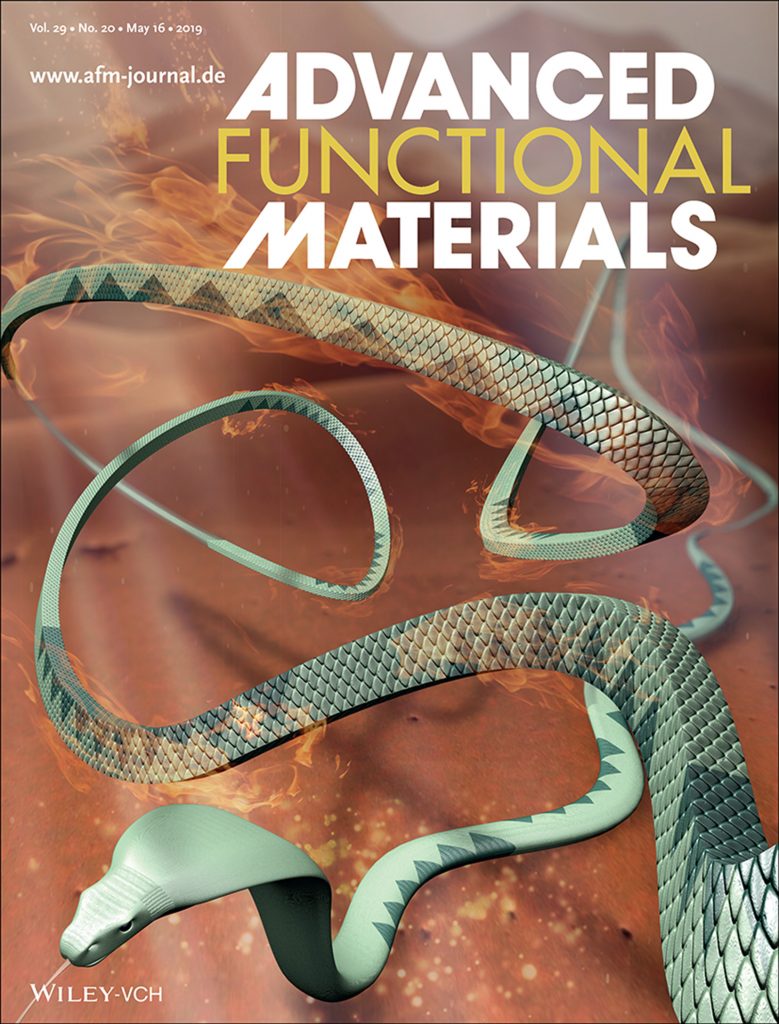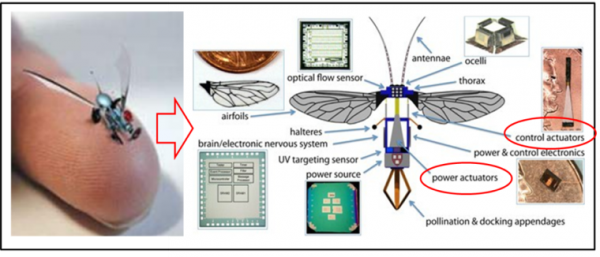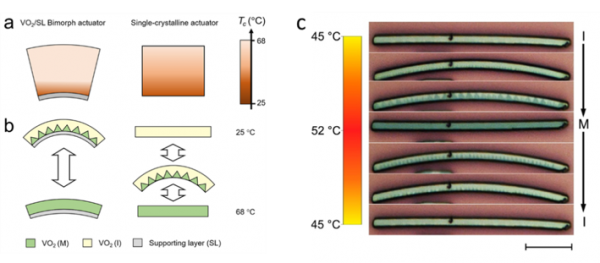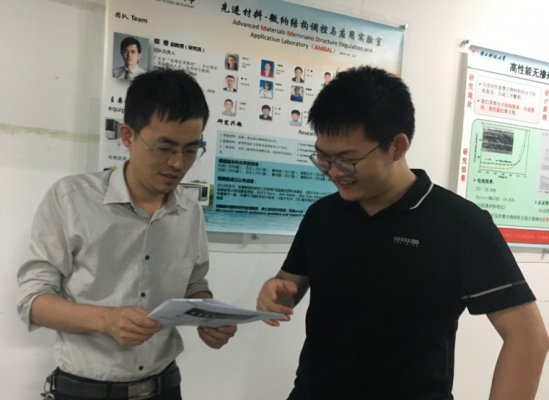With the development of miniaturized devices, there grows an urgent demand for microactuators that can be integrated into microelectromechanical systems (MEMS) and miniature robotics. The microactuators that convert other kinds of energy to mechanical energy are responsible for the moving and controlling operations in these microsystems. The microactuators have attracted increasing attention and are expected to obtain convincing advances in areas including controllable displacement, large force, high speed, high work power, multiple-stimuli response, good compatibility, and high durability in harsh conditions. The importance of mechanical manipulation or positioning with extreme precision has also been gradually recognized in sophisticated MEMS or ultraprecision microrobotics.

Associate Professor Cheng Chun from the Department of Materials Science and Engineering at Southern University of Science and Technology (SUSTech) has led his research team to publish a new paper on smart materials. Their paper, titled “Single-Crystalline Vanadium Dioxide Actuators,” was published in Advanced Functional Materials (IF=13.325) and selected as the Inside Back Cover article. Their work recognized the single crystal driving device for the first time, by engineering the ordered domain structure of the vanadium dioxide single crystal at the micro/nano scale. This means that it is now possible to provide high-performance, high-stability micro/nano single-crystalline robots.
Microactuators based on conventional driving materials such as piezoelectric materials, shape memory alloy (SMA), bimetal structures and polymers or newer materials like nanocarbon materials, nanoporous metals, transition metal oxides and MoS2 have shortcomings in specific areas, which means that they can perform some of the tasks required, but not all. It has long been a great challenge to balance most of the aspects of actuation performance with conventional and new driving materials.

On the other hand, great progress has been made in vanadium dioxide (VO2)-based actuators using a crystalline form that gives them supreme actuation performance, while maintaining its other positive properties. VO2-based actuators operate through changes in phase, which makes them ideal for both high power density and high frequency response output actuators. While conventional forms of VO2-based actuators have reached their limits, Associate Professor Cheng Chun’s team wanted to find a new approach for VO2-based actuators.
The traditional vanadium dioxide actuator is a bimorph actuator composed of a one-dimensional vanadium dioxide structure and a high elastic support layer. As the temperature changes, the double-layer interface stress causes the vanadium dioxide structure to form a radially asymmetric phase transition gradient. Up to 1% radial asymmetrical strain eventually leads to bending drive behavior. This double-layer actuator has the advantages of large theoretical amplitude, high energy density, fast response, etc., but it is also limited by some inherent defects of the composite structure, such as residual stress generated during the preparation process, formation of metastable phase, nonlinear drive behavior, and poor environmental tolerance. Therefore, achieving a radially asymmetric phase transition in a single vanadium dioxide one-dimensional structure is an important breakthrough to solve the above problems.

The team was able to introduce a non-uniform reduction reaction atmosphere to the growth of VO2 single crystal, breaking its crystal symmetry. The team discovered that the gradient phase transition regulation is realized in the highly symmetric radial direction of the single-crystalline nanowire, leading to the bi-directional bending of the nanowire with changes in temperature. The single-crystalline actuator not only maintains the outstanding actuation performance but also demonstrates excellent structural and chemical stability, which solves the problems of conventional VO2 actuators.
Their research was highly rated by reviewers. One peer reviewer said, “This manuscript will definitely be of significance and have an impact on the development of thermal actuators and the use of vanadium dioxide material as active element in such devices.” Another added “The authors have done a very good research work, and I am sure that this paper on single crystal VO2 actuators will be of high impact and heavily cited”.

Associate Professor Cheng Chun is the sole correspondent of the work. Southern University of Science and Technology is the first communication unit of the work; Shi Run, the first author of the thesis, was a 2012 undergraduate student of our school, who has since returned to SUSTech for his Ph.D. study under a joint SUSTech/Hong Kong University of Science and Technology (HKUST) program. He has published 19 papers and 6 first author papers, including 2 IF>10 papers. The materials characterization in this work was strongly supported by Materials Characterization and Preparation Center (MCPC) of SUSTech and Professor Wang Ning of HKUST. SUSTech undergraduate students Kong Dejun, Cai Nianzhen and Chen Pengcheng also participated in some related work.
The work received the National Natural Science Foundation of China, the National Key Research and Development Project from the Ministry of Science and Technology, the Guangdong Provincial Science and Technology Development Special Fund the Guangdong-Hong Kong joint innovation project, the Guangdong Natural Science Funds for Distinguished Young Scholars, and Training Program for Outstanding Young Teachers at Higher Education Institutions of Guangdong Province. It also received support from the Hong Kong Research Grants Council and SUSTech.
Original paper: https://onlinelibrary.wiley.com/doi/full/10.1002/adfm.201900527
Representative paper information and links:
[1] R. Shi, N. Shen, J. Wang, W. Wang, A. Amini, N. Wang, C. Cheng*, Recent Advances in Fabrication Strategies, Phase Transition Modulation and Advanced Applications of Vanadium Dioxide. Appl. Phys. Rev. 6 (2019), 011312 (Featured article, journal website headlines recommended)
https://aip.scitation.org/doi/full/10.1063/1.5087864
[2] R. Shi, X. Cai, W. Wang, J. Wang, D. Kong, N. Cai, P. Chen, P. He, Z. Wu, A. Amini, N.Wang and C. Cheng *. Single-Crystalline VO2 Actuators. Adv. Funct. Mater. 2019, 1900527 (Nature Index included journal, cover article)
https://onlinelibrary.wiley.com/doi/full/10.1002/adfm.201900527






